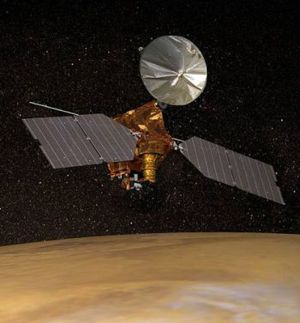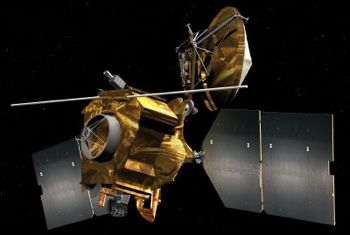
Home - Search - Browse - Alphabetic Index: 0- 1- 2- 3- 4- 5- 6- 7- 8- 9
A- B- C- D- E- F- G- H- I- J- K- L- M- N- O- P- Q- R- S- T- U- V- W- X- Y- Z
Mars Reconnaissance Orbiter
 Mars Reconn Orbiter |
AKA: MRO. Status: Operational 2005. First Launch: 2005-08-12. Last Launch: 2005-08-12. Number: 1 . Gross mass: 2,180 kg (4,800 lb). Unfuelled mass: 1,031 kg (2,272 lb). Diameter: 6.50 m (21.30 ft). Span: 13.60 m (44.60 ft).
During its two-year primary science mission, the Mars Reconnaissance Orbiter was to conduct eight different science investigations at Mars, involving global mapping, regional surveying, and high-resolution targeting of specific spots on the surface.
Propulsion
The propulsion subsystem was used for major maneuvers. It could also be used to control the spacecraft's position, as a backup to the primary reaction wheel system. The hydrazine monopropellant pressure-fed system included a single tank with a capacity of 1187 kilograms of usable propellant. This equated to a delta-V of 1.4 km/s. Over 70% of the propellant would be consumed in the Mars orbit insertion maneuver.
Six large MR-107N thrusters, each producing 270 Newtons, were used for the Mars orbit insertion burn. Six medium MR-106E thrusters, each producing 22 Newtons, were used for trajectory correction maneuvers, and to the spacecraft during the Mars orbit insertion burn. Eight small MR-103D thrusters, each producing 0.9 Newtons provided back-up attitude control to the reaction wheels and fine during Mars orbit insertion and trajectory correction maneuvers.
Electrical power was provided by two solar panels, each an area of 10 square meters and contained 3,744 individual solar cells with an efficiency of 26%. Power was delivered at 32 volts. The two panels together produced 1,000 Watts of power at Mars. During aerobraking, the solar panels acted as drag brakes, reaching 200 Celsius due to aerodynamic heating. The solar panels charged two Nickel-Hydrogen rechargeable batteries, each with a storage capacity of 50 Ampere-hours.
Payloads included:
- HiRISE (High Resolution Imaging Science Experiment): This visible spectrum camera could reveal small-scale objects in the debris blankets of mysterious gullies and details of geologic structure of canyons, craters, and layered deposits.
- CTX (Context Camera): This camera would provide wide area views to help provide a context for high-resolution analysis of key spots on Mars provided by HiRISE and CRISM.
- MARCI (Mars Color Imager): This weather camera would monitor clouds and dust storms.
- Spectrometer: CRISM (Compact Reconnaissance Imaging Spectrometer for Mars) - This instrument would identify minerals, especially those likely formed in the presence of water, in surface areas on.
- MCS (Mars Climate Sounder) - This radiometer functioned as an atmospheric profiler to detect vertical variations of temperature, dust, and water vapor concentrations in the Martian atmosphere. Radar:
- SHARAD (Shallow Radar) - This sounding radar would probe beneath the Martian surface to see if water ice was present at depths greater than one meter.
- Electra UHF Communications and Navigation Package - Electra allowed the spacecraft to act as a communications relay between the Earth and landed crafts on Mars that did not have sufficient radio power to communicate directly with Earth by themselves.
- Optical Navigation Camera - This camera was being tested for improved navigation capability for future missions. If it performed well, similar cameras placed on orbiters of the future would be able to serve as high-precision interplanetary "eyes" to guide incoming spacecraft as they neared Mars.
- Ka-band Telecommunications Experiment Package - Mars Reconnaissance Orbiter would test the use of a radio frequency called Ka-band to demonstrate the potential for greater performance in communications using significantly less power.
- Gravity Field Investigation Package - By tracking the orbiter in the primary science phase, team members would be able to map the gravity field or Mars to understand the geology of the surface and near-surface and the geophysical processes that produce these land features.
- Atmospheric Structure Investigation Accelerometers - Data collected from accelerometers during aerobraking would help scientists understand the structure of the Martian atmosphere.
Mission Phases
The mission was broken into the following phases following launch from earth:
- Mars Orbit Insertion - March 2006: The spacecraft approached Mars under the southern hemisphere at an altitude of about 300 kilometers traveling at 3 km/s. The 1 km/s Mars orbit insertion burn would last about 25 minutes, resulting in an elliptical 300 km x 45,000 km orbit with a period of 35 hours.
- Aerobraking - March 2006 - November, 2006: The spacecraft would use atmospheric drag to reach its 450 km altitude, two-hour period science orbit.
- Science Operations - November 2006 - November 2008: The primary science phase was to last for at least one Martian year, from the end of solar conjunction in November 2006. The spacecraft would conduct daily global mapping and profiling observations, regional survey campaigns, and high-resolution study of hundreds of globally distributed specific sites. Many targeted observations would involve simultaneous coordinated observations by more than one instrument. 34 Terabits of data would be returned during this phase to two 34-meter Deep Space Network antennae on earth - 20 times more data than previous Mars missions and more data than all previous planetary missions combined.
- Communications Relay - November 2008 - December 2010: The spacecraft would relay data from spacecraft landed on the Martian surface back to earth.
NASA NSSDC Master Catalog Description
The Mars Reconnaissance Orbiter (MRO) is designed to orbit Mars over a full martian year and gather data with six scientific instruments, including a high-resolution imager. The science objectives of the mission are to: characterize the present climate of Mars and its physical mechanisms of seasonal and interannual climate change; determine the nature of complex layered terrain on Mars and identify water-related landforms; search for sites showing evidence of aqueous and/or hydrothermal activity; identify and characterize sites with the highest potential for landed science and sample return by future Mars missions; and return scientific data from Mars landed craft during a relay phase. MRO will return high resolution images, study surface composition, search for subsurface water, trace dust and water in the atmosphere, and monitor weather.
Spacecraft and Subsystems
The Mars Reconnaissance Orbiter consists of a main bus, constructed of titanium, carbon composites, and aluminum honeycomb. Extending from the bus are two solar panel wings and a 3 meter high-gain antenna dish. The bus houses the propulsion system, telecommunications, command, guidance, and science instruments. The maximum spacecraft mass is 2180 kg, which includes 1149 kg of propellants.
Propulsion is provided by a total of 20 thrusters. Six 170 N (Newton) monopropellant (hydrazine) main-engine thrusters are used for the Mars Orbit insertion burn, a maneuver which will require about 70% of the total fuel onboard. Six 22 N thrusters are used for trajectory correction maneuvers and eight 0.9 N thrusters for pointing. All thrusters are fed from a single propellant tank mounted near the center of the main bus. A pressurant tank is used to force propellant to the motors. Spacecraft control is achieved with the use of reaction wheels and reaction control system thrusters. Navigation and attitude knowledge is determined by 16 sun sensors, two star tracker cameras, and two inertial measurement units, which use accelerometers and gyroscopes.
Two way telecommunications will be via X-band at about 8000 MHz, primarily through a 3 m diameter steerable high-gain dish antenna. Two low-gain Ka-band antennas, mounted on the high-gain dish, are also available for transmission and reception. Two transponders and three traveling wave tube amplifiers allow maximum data rates of 6 megabits/sec. Power is provided by the two solar cell arrays on wings mounted on opposite side of the bus. Each array has an area of 10 square meters and contains 3744 solar cells. The panels produce 1000 Watts at Mars which is used to run the equipment directly and also to charge two nickel-hydrogen 50 A-hr, 32-volt batteries. Thermal control is achieved by a combination of radiators, surface coatings, insulation, and heaters.
MRO's science payload includes the High Resolution Imaging Science Experiment (HiRISE), a visible stereo imaging camera; the Compact Reconnaissance Imaging Spectrometer for Mars (CRISM), a visible/near-infrared spectrometer to study the surface composition; the Mars Climate Sounder (MCS), an infrared radiometer to study the atmosphere, a shallow subsurface sounding radar (SHARAD) provided by the Italian Space Agency to search for underground water; the Context Camera (CTX), to provide wide-area views; and the Mars Color Imager (MARCI), to monitor clouds and dust storms. In addition, there are three engineering instruments aboard MRO: the Electra UHF communications and navigation package, which will be used as a relay between the Earth and future Mars missions; the optical navigation camera, which will be tested for possible navigational use on future planetary spacecraft; and the Ka-band telecommunications experiment package, which will be testing high performance Ka-band communications. Engineering accelerometer data will be used to study the structure of the martian atmosphere and tracking of the orbiter will be used to study the gravity field of Mars.
Mission Profile
Launch on an Atlas V-401 took place at 11:43 UT (7:43 a.m. EDT) on 12 August 2005 from Kennedy Space Center. The cruise to Mars took seven months and included checkouts, calibrations, navigation, and five trajectory correction maneuvers. On 10 March 2006 MRO reached Mars and perform a Mars orbit insertion maneuver, passing under the southern hemisphere of Mars and firing its main engines for about 27 minutes. Signals that the burn has started reached Earth at 21:24 UT (4:24 p.m. EST) on 10 March. With 6 minutes left in the burn MRO passed behind Mars as seen from Earth. Radio communication resumed when it re-emerged about 30 minutes later.
Mars Reconnaissance Orbiter reached Mars and went into orbit on 10 March 2006. The signal that the orbit insertion burn started reached Earth at 21:24 UT (4:24 p.m. EST). The first signals following its reappearance reached Earth at about 22:16 UT (5:16 EST). The 1641 second burn slowed the spacecraft by about one km/sec, leaving it in a 400 x 35000 km polar capture orbit with a 35 hour period. Aerobraking was used over the next six months to lower the orbit to the 255 x 320 km science orbit (with periapsis over the south pole and apoapsis over the north pole). There are twelve sun-synchronous orbits per day so that the orbiter will always see the ground at 3:00 p.m. local time at the equator. Science operations began at the end of solar conjunction in November 2006, and, with multiple extensions to the mission, continue to the present (as of September, 2015). Total cost of the mission is estimated at about $720 million.
More at: Mars Reconnaissance Orbiter (MRO).
Family: Mars orbiter. Country: USA. Engines: MR-107. Launch Vehicles: Atlas V, Atlas V 401. Projects: Mars. Launch Sites: Cape Canaveral, Cape Canaveral LC41. Bibliography: 2, 3951, 3952, 3953, 6689, 12811.
 | Mars Reconnaissance Credit: Manufacturer Image |
2005 August 12 - . 11:43 GMT - . Launch Site: Cape Canaveral. Launch Complex: Cape Canaveral LC41. Launch Pad: SLC41. LV Family: Atlas V. Launch Vehicle: Atlas V 401.
- Mars Reconnaissance Orbiter - . Mass: 2,180 kg (4,800 lb). Nation: USA. Agency: JPL, NASA. Manufacturer: Lockheed. Class: Mars. Type: Mars probe. Spacecraft: Mars Reconnaissance Orbiter. USAF Sat Cat: 28788 . COSPAR: 2005-029A. Transferred from Atlas 3B. Delayed from August 10 and 11, 2005..
2006 March 10 - .
- Mars Reconnaissance Orbiter, Mars Orbit Insertion - . Nation: USA. Spacecraft: Mars Reconnaissance Orbiter.
Back to top of page
Home - Search - Browse - Alphabetic Index: 0- 1- 2- 3- 4- 5- 6- 7- 8- 9
A- B- C- D- E- F- G- H- I- J- K- L- M- N- O- P- Q- R- S- T- U- V- W- X- Y- Z
© 1997-2019 Mark Wade - Contact
© / Conditions for Use